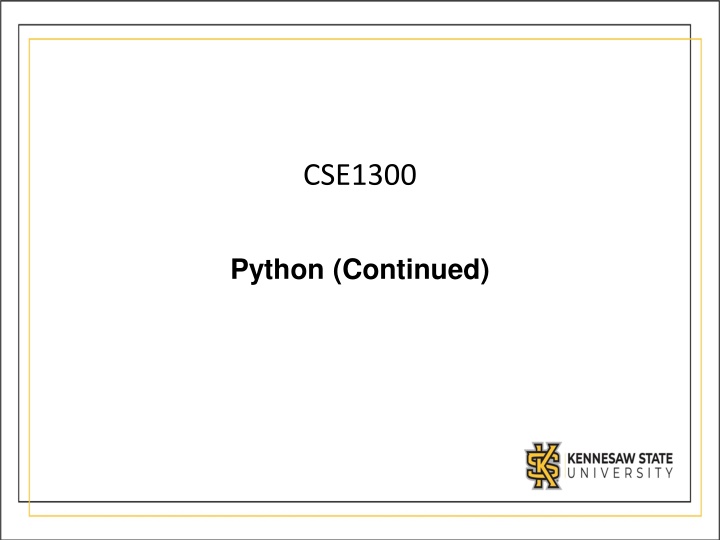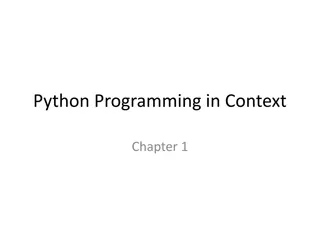
Mastering Python: Understanding Conditionals and Loops for Efficient Programming
Dive into the core of programming logic with conditionals and loops in Python. Explore how these essential concepts enable decision-making and automate repetitive tasks, making your code more efficient and robust. Discover the power of if, if-else, if-elif-else statements, and nested conditionals for effective programming.
Download Presentation

Please find below an Image/Link to download the presentation.
The content on the website is provided AS IS for your information and personal use only. It may not be sold, licensed, or shared on other websites without obtaining consent from the author. If you encounter any issues during the download, it is possible that the publisher has removed the file from their server.
You are allowed to download the files provided on this website for personal or commercial use, subject to the condition that they are used lawfully. All files are the property of their respective owners.
The content on the website is provided AS IS for your information and personal use only. It may not be sold, licensed, or shared on other websites without obtaining consent from the author.
E N D
Presentation Transcript
CSE1300 Python (Continued)
Why Learn Conditionals and Loops? Core of Programming Logic: Conditionals and loops enable decision- making and repetition, two fundamental pillars of programming. Common Scenarios: Conditionals: Checking user input validity, responding to different cases. Loops: Automating tasks that repeat, iterating over data structures.
Conditionals Conditionals let your program choose different paths based on true/false conditions. if if-else if-elif-else Syntax: if condition: # code executed if condition is True else: # code executed if condition is False
The if Statement age = 18 if age >= 18: print("You are an adult!") Explanation: Checks if age >= 18. If that s true, it executes the print() statement inside the block. If it s false, the program skips that block. Indentation: Remember to indent the code (usually 4 spaces) inside the if block.
The if-else Statement age = 16 if age >= 18: print("You are an adult.") else: print("You are a minor.") Explanation: If the condition in if is met, the first block runs. Otherwise (else), the second block runs. Use Case: Perfect for an either/or scenario (adult vs. minor, success vs. failure, etc.).
The if-elif-else Statement grade = 85 if grade >= 90: print("A") elif grade >= 80: print("B") elif grade >= 70: print("C") else: print("F")
The if-elif-else Statement Multiple Checks: First if checks one condition; if not met, elif checks the next, etc. else covers any scenario not already handled by previous conditions. Avoid Long Chains: If conditions get too long, consider other structures (e.g., dictionaries, lookup tables).
Nested Conditionals Placing an if-else block inside another if-else block. x = 5 if x > 0: print("x is positive") if x % 2 == 0: print("and even") else: print("and odd") When to Use: Handling sub-conditions within a main condition. Caution: Too many nested levels can make code hard to read strive for clarity.
Best Practices for Conditionals 1. Keep Conditions Simple: Use straightforward comparisons. 2. Combine Logical Operators: (x > 5) and (x < 10), for example. 3. Limit Nesting: Deeply nested code is hard to maintain. 4. Descriptive Variables: Improves readability (e.g., is_logged_in instead of x). 5. Consistency: Always maintain proper indentation.
Loops A loop repeatedly executes a block of code while a condition holds or through a sequence of items. Two Main Loop Types in Python: 1. for loop 2. while loop Use Cases: Iterating over a range of numbers. Processing each item in a list. Repeating a piece of code until a condition is met.
The for Loop for item in sequence: # do something with item Sequence Examples: Lists, strings, ranges, or any iterable object. fruits = ["apple", "banana", "cherry"] for fruit in fruits: print(fruit) Prints each item in the fruits list.
Using range() with for for i in range(5): print(i) Outputs: 0, 1, 2, 3, 4 Why Use range(): Generates a sequence of integers. Variants: range(start, stop): start inclusive, stop exclusive. range(start, stop, step): control step size.
The while Loop while condition: # code block Execution: Continues to run as long as condition is True. count = 0 while count < 5: print("Count is:", count) count += 1 Key Point: Make sure the loop eventually ends (e.g., incrementing count).
Controlling Loops break and continue break: Exits the loop immediately. for i in range(10): if i == 5: break print(i) # stops printing at 4 continue: Skips the rest of the current iteration and moves to the next. for i in range(5): if i == 2: continue print(i) # skips printing 2
Controlling Loops break and continue Use Cases: break: Exit early if a certain condition is met. continue: Skip unwanted iterations.
Nested Loops A loop inside another loop. for i in range(3): for j in range(2): print(i, j) When to Use: Iterating over multi-dimensional structures (e.g., 2D lists). Performance Caution: Nested loops can grow the number of operations quickly use carefully for large datasets.
Best Practices for Loops Use Meaningful Names: Avoid for x in y:; choose descriptive variable names. Keep Loop Bodies Simple: Complex logic can be split into functions. Watch for Infinite Loops: Make sure while loops will eventually become false. Use enumerate() or zip(): Helps manage indices and multiple sequences more cleanly.
Built-In Libraries Definition: Python s standard library is a collection of modules that come pre-installed, offering a wide range of functionalities. Why Use Them: Save time: No need to reinvent the wheel for common tasks. High reliability: Maintained and tested by the Python core team
import math Use math or any other built-in module. Provides mathematical functions (trigonometry, exponentiation, etc.). import math print(math.sqrt(16)) # 4.0 print(math.pow(2, 3)) # 8.0 print(math.pi) # 3.141592653589793 Efficiently handle many common math operations without writing them yourself.
import random Generating random numbers, picking random items. import random print(random.random()) # between 0.0 and 1.0 print(random.randint(1, 10)) # integer between 1 and 10 fruits = ["apple", "banana", "cherry"] print(random.choice(fruits)) # picks a random fruit Usage: Great for small games, simulations, or testing.
import datetime Work with dates and times. from datetime import datetime now = datetime.now() print("Current date and time:", now) print("Year:", now.year) print("Month:", now.month) print("Day:", now.day) Use Cases: Logging events, scheduling tasks, or formatting time.
os and sys os: Interact with your operating system (create directories, list files, etc.). import os print(os.getcwd()) # current working directory sys: Access system-specific parameters and functions (like command- line arguments). import sys print(sys.argv) # list of command-line arguments
How to Import Modules Import Methods: 1. Basic: import math 2. Alias: import math as m 3. Selective: from math import sqrt, pi 4. Wildcard (not recommended): from math import * Why Different Methods? Alias shortens module names. Selective imports only bring in the parts you need. Wildcard can cause name conflicts.
Exploring the Python Standard Library Documentation Official Docs: docs.python.org Organization: Categorized by module name, e.g., math, random, datetime, etc. Why Use Docs?: See what functions and classes are available. Learn about parameters, return values, and examples.
Combining Conditionals, Loops, and Libraries Example: Guessing Game import random secret_number = random.randint(1, 10) attempts = 0 while True: guess = int(input("Guess a number between 1 and 10: ")) attempts += 1 if guess < secret_number: print("Too low! Try again.") elif guess > secret_number: print("Too high! Try again.") else: print(f"Correct! It took you {attempts} tries.") break
Explanation: 1. Uses random to generate a secret number. 2. Uses a while True loop to keep asking until guessed correctly. 3. Conditionals (if-elif-else) to guide the user s guesses. 4. break to exit the loop after the correct guess.
Debugging & Common Errors Infinite Loops: Forgetting to update a loop variable in a while loop. Indentation Issues: Misaligned blocks can cause unexpected logic flow or errors. NameError: Not importing a module but trying to use it. SyntaxError: Typos, missing colons, or parentheses in conditionals/loops. Fix Strategies: Print debugging statements, check variable updates, and carefully review indentation.






















